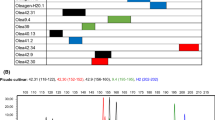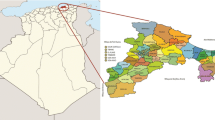Abstract
Twelve new microsatellites have been developed in olive. For that purpose, a genomic library of the olive cultivar ‘Arbequina’ was enriched for GA, GT and ACT repeats. Two methods of screening yielded 27 sequences containing microsatellites out of the 119 clones sequenced. The GA repeat seems to be the most abundant motif. Among sequences containing microsatellites, 4 (14.8%) were redundant, 1 (3.7%) was previously described in the literature and 12 (44.4%) could not be used for primers design because the repeat motifs were incomplete. Suitable primer pairs were obtained for the remaining 10 (37.0%) sequences plus an additional 14 recovered from a formerly developed library. For the 24 primer pairs designed, 4 failed to amplify, 8 produced a complex bands pattern and 12 succeeded in giving amplification products. Considering these 12 primer pairs, 10 showed single locus amplification, whereas the other 2 revealed two loci each. This was demonstrated by studying allele segregation in two olive progenies. Sixty-eight alleles were detected for the 12 microsatellites when 51 olive cultivars were analysed. The number of alleles per locus ranged from 1 to 13. The expected heterozygosity varied between 0 and 0.83. All pairs of cultivars could be distinguished using only three microsatellites due to their great discrimination power value. The data coming from genotyping the 51 olive cultivars for 7 out of the 12 new microsatellites were used for constructing a dendrogram by unweighted pair group method with arithmetic mean cluster analysis using the Dice similarity coefficient. Cultivar association according to their geographical origin was observed.

Similar content being viewed by others
References
Angiolillo A, Mencuccini M, Baldoni L (1999) Olive genetic diversity assessed using amplified fragment length polymorphisms. Theor Appl Genet 98:411–421
Aranzana MJ, García-Mas J, Carbó J, Arús P (2002) Development and variability analysis of microsatellite markers in peach. Plant Breed 121:87–92
Bandelj D, Jakše J, Javornik B (2004) Assessment of genetic variability of olive varieties by microsatellite and AFLP markers. Euphytica 136:93–102
Barranco D, Rallo L (1984) Las variedades de olivo cultivadas en Andalucía. M° de Agricultura, Junta de Andalucía, Madrid, Spain
Belaj A, Trujillo I, De la Rosa R, Rallo L (2001) Polymorphism and discrimination capacity of randomly amplified polymorphic markers in an olive germplasm bank. J Am Soc Hortic Sci 126:64–71
Belaj A, Satovic Z, Rallo L, Trujillo I (2002) Genetic diversity and relationships in olive (Olea europaea L.) germplasm collections as determined by amplified polymorphic DNA. Theor Appl Genet 105:638–644
Belaj A, Satovic Z, Cipriani G, Baldoni L, Testolin R, Rallo L, Trujillo I (2003) Comparative study of the discriminating capacity of RAPD, AFLP and SSR markers and of their effectiveness in establishing genetic relationships in olive. Theor Appl Genet 107:736–744
Besnard G, Bervillé A (2000) Multiple origins for Mediterranean olive (Olea europaea L. ssp europaea) based upon mitochondrial DNA polymorphisms. Life Sci 323:173–181
Carriero F, Fontanazza G, Cellini F, Giorio G (2002) Identification of simple sequence repeats (SSRs) in olive (Olea europaea L.). Theor Appl Genet 104:301–307
Cipriani G, Lot G, Huang W-G, Marrazzo MT, Peterlunger E, Testolin R (1999) AC/GT and AG/CT microsatellite repeats in peach [Prunus persica (L) Batsch]: isolation, characterisation and cross-species amplification. Theor Appl Genet 99:65–72
Cipriani G, Marrazzo MT, Marconi R, Cimato A, Testolin R (2002) SSR markers isolated in olive (Olea europaea L.) are suitable for individual fingerprinting and reveal polymorphism within ancient cultivars. Theor Appl Genet 104:223–228
Civantos L (1996) La olivicultura en el mundo y en España. In: Barranco D, Fernández-Escobar R, Rallo L (eds) El cultivo del olivo. Junta de Andalucía, Consejería de Agricultura y Pesca, Sevilla, Spain, pp 15–32
De la Rosa R, James CM, Tobutt KR (2002) Isolation and characterization of polymorphic SSRs in olive (Olea europaea L.) and their transferability to other genera in the Oleaceae. Mol Ecol Notes 2:265–267
De la Rosa R, Angiolillo A, Guerrero C, Pellegrini M, Rallo L, Besnard G, Bervillé A, Martín A, Baldoni L (2003) A first linkage map of olive (Olea europaea L.) cultivars using RAPD, AFLP, RFLP and SSR markers. Theor Appl Genet 106:1273–1282
De la Rosa R, James CM, Tobutt KR (2004) Using microsatellite markers to check parentage of some olive progenies. HortScience 39:351–354
Díaz A, Martín A, Rallo P, Barranco D, De la Rosa R (2006) Self-incompatibility of ‘Arbequina’ and ‘Picual’ olive assessed by SSR markers. J Am Soc Hortic Sci 131:250–255
Dice LR (1945) Measures of the amount of ecologic association between species. Ecology 26:297–302
Fabbri A, Hormaza JI, Polito VS (1995) Random amplified polymorphic DNA analysis of olive (Olea europaea L.) cultivars. J Am Soc Hortic Sci 120:538–542
Fisher PJ, Richardson TE, Gardner RC (1998) Characteristics of single- and multi-copy SSRs from Pinus radiata. Theor Appl Genet 96:969–979
Guilford P, Prakash S, Zhu JM, Rikkerink E, Gardiner S, Bassett H, Forster R (1997) Microsatellites in Malus X domestica (apple): abundance, polymorphism and cultivar identification. Theor Appl Genet 94:249–254
Hamada H, Petrini MG, Kakunaga T (1982) A novel repeated element with Z-DNA-forming potential is widely found in evolutionary diverse eukaryotic genomes. Proc Natl Acad Sci USA 79:6465–6469
Hess J, Kadereit JW, Vargas P (2000) The colonization history of Olea europaea L. in Macaronesia based on internal transcribed spacer 1 (ITS-1) sequences, randomly amplified polymorphic DNAs (RAPD), and intersimple sequences repeat (ISSR). Mol Ecol 9:857–868
Hodgetts RD, Aleksiuk MA, Brown A, Clarke C, Macdonald E, Nadeem S, Khasa D (2001) Development of SSR markers for white spruce (Picea glauca) and related species. Theor Appl Genet 102:1252–1258
Liebhard R, Gianfranceschi L, Koller B, Ryder CD, Tarchini R, Van De Weg E, Gessler C (2002) Development and characterisation of 140 new microsatellites in apple (Malus x domestica Borkh.). Mol Breed 10:217–241
Marinoni D, Akkak A, Bounous G, Edwards KJ, Botta R (2003) Development and characterization of microsatellite markers in Castanea sativa (Mill.). Mol Breed 11:127–136
Messier W, Li S, Stewart C (1996) The birth of microsatellites. Nature 381:483
Metzgar D, Bytof J, Wills C (2000) Selection against frameshift mutations limits microsatellite expansion in coding DNA. Genome Res 10:72–80
Murray MG, Thompson WF (1980) Rapid isolation of high-molecular-weight DNA. Nucleic Acids Res 8:4321–4325
Nei M (1973) Analysis of gene diversity in subdivided populations. Proc Natl Acad Sci USA 70:3321–3323
Rallo P (2001) Desarrollo y aplicación de microsatélites en olivo. Ph.D. thesis, University of Córdoba, Spain
Rallo P, Dorado G, Martín A (2000) Development of simple sequence repeats (SSRs) in olive tree (Olea europaea L.). Theor Appl Genet 101:984–989
Rallo P, Tenzer I, Gessler C, Baldoni L, Dorado G, Martín A (2003) Transferability of olive microsatellite loci across the genus Olea. Theor Appl Genet 107:940–946
Rugini E, Lavee S (1992) Olive. In: Hammerschlag FA, Litz RE (eds) Biotechnology of perennial fruit crops. CAB, Wallingford, UK, pp 371–382
Sambrook J, Fritsch EF, Maniatis T (1989) Molecular cloning: a laboratory manual, 2nd edn. Cold Spring Harbor Laboratory Press, Cold Spring Harbor, NY
Sanz-Cortés F, Badenes ML, Paz S, Íñiguez A, Llácer G (2001) Molecular characterization of olive cultivars using RAPD markers. J Am Soc Hortic Sci 126:7–12
Scotti I, Magni F, Paglia GP, Morgante M (2002) Trinucleotide SSRs in Norway spruce (Picea abies), their features and the development of molecular markers. Theor Appl Genet 106:40–50
Sefc KM, Lopes S, Mendonça D, Rodrigues Dos Santos M, Laimer da Câmara Machado M, da Câmara Machado A (2000) Identification of SSR loci in olive (Olea europaea) and their characterization in Italian and Iberian olive trees. Mol Ecol 9:1171–1173
Taylor JS, Durkin JMH, Breden F (1999) The death of a microsatellite: a phylogenetic perspective on microsatellite interruptions. Mol Biol Evol 16:567–572
Tessier C, David J, This P, Boursiquot JM, Charrier A (1999) Optimization of the choice of molecular markers for varietal identification in Vitis vinifera L. Theor Appl Genet 98:171–177
Testolin R, Marrazzo T, Cipriani G, Quarta R, Verde I, Dettori MT, Pancaldi M, Sansavini S (2000) Microsatellite DNA in peach (Prunus persica L. Batsch) and its use in fingerprinting and testing the genetic origin of cultivars. Genome 43:512–520
Trujillo I, Rallo L, Arús P (1995) Identifying olive cultivars by isozyme analysis. J Am Soc Hortic Sci 120:318–324
Wang Z, Weber JL, Zhong G, Tanksley SD (1994) Survey of plant short tandem DNA repeats. Theor Appl Genet 88:1–6
Wu SB, Collins G, Sedgley M (2004) A molecular linkage map of olive (Olea europaea L.) based on RAPD, microsatellite, and SCAR markers. Genome 47:26–35
Acknowledgements
The assistance of Dr. Dorado in the design of primers is acknowledged with gratitude. The authors are grateful to the World Olive Germplasm Bank of CIFA ‘Alameda del Obispo’ in Córdoba (Spain) for the easy access to the plant material. This research was supported by the ‘CAO00-018-C7-1’ project of the Spanish Ministry of Agriculture, Food and Fisheries and by the European OLIV-TRACK project. Aurora Díaz is grateful for the granting of a predoctoral fellowship to ‘Junta de Andalucía’.
Author information
Authors and Affiliations
Corresponding author
Rights and permissions
About this article
Cite this article
Díaz, A., De la Rosa, R., Martín, A. et al. Development, characterization and inheritance of new microsatellites in olive (Olea europaea L.) and evaluation of their usefulness in cultivar identification and genetic relationship studies. Tree Genetics & Genomes 2, 165–175 (2006). https://doi.org/10.1007/s11295-006-0041-5
Received:
Revised:
Accepted:
Published:
Issue Date:
DOI: https://doi.org/10.1007/s11295-006-0041-5




